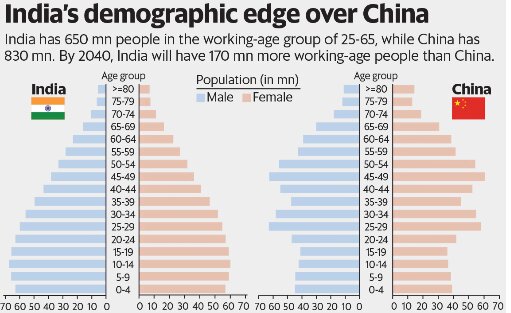Indian Society
Population Pyramid
- 27 Sep 2019
- 3 min read
A population pyramid is a graphical representation of the age and sex composition of a specific population.
- It consists of two histograms, one for each gender (by convention, men on the left and women on the right) where the numbers are shown horizontally and the ages vertically.
- The numbers by gender and by age depend on interactions between fertility, mortality and migrations.
- The shape of the pyramid and its variations over the years depend, above all, on the variations in fertility.
- The pyramid can also assume a columnar shape (with vertical sides rather than sloped sides), or have an irregular profile.
India vis-a-vis China
- India’s pyramid is bottom heavy i.e. the Indian population has a larger proportion of children, teenagers and young adults compared to China’s.
- Population Distribution
- India
- The country’s population for the age cohorts of 0-4, 5-9, 10-14 and 15-19 is roughly equal, whereas the numbers for older groups become progressively smaller.
- This means that the country’s younger age groups have stopped growing in numbers now and are likely to shrink slightly soon.
- This, however, does not mean that India’s population will also start shrinking soon.
- Except for the oldest groups, India seems to have more males than females for every cohort.
- China
- The country’s largest cohort is in its late 40s, although it is more gender balanced than its younger cohorts, suggesting that sex-selective abortions are likely to have taken off in the last few decades.
- India
- Working Age Population
- In 25-65 age group, India currently has around 650 million people and China 830 million.
- By 2040, India is likely to reach 900 million, whereas China will have around 730 million.
- In other words, India will go from having 180 million less working-age people than China today to about 170 million more—a net gain of a third of a billion in 20 years.
Way Forward
- Just having people in the working age is not enough. How many are in the labour force and their productivity are important. The government needs to focus on the same.
- India needs to invest more, and efficiently, in human capital and infrastructure.
- For the former, investments in health and sanitation have to be sustained and more Public Private Partnership (PPP) models are required to ensure basic education.
- For the latter, a bigger push for affordable rental housing in cities has to be considered, along with more investments in rail connectivity.







